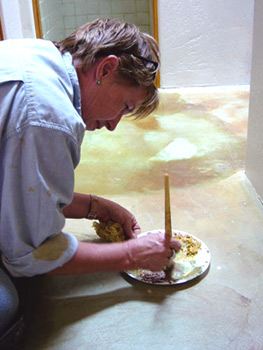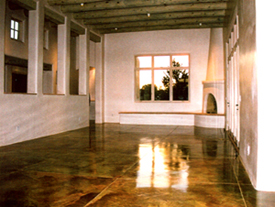|
April 13, 2004
In This Issue of The Acid Staining Newsletter
Word of the Day - Plasticizer Migration
Slippery Floors
Word of the Day - Plasticizer Migration
After years of talking about "tape pull-up," I finally learned the proper name for some strange effects which we have been getting when plastic materials are laid upon our sealed floors for any length of time. The scientific term for this event is "plasticizer migration."
A plasticizer is any one of a group of substances used in making plastic which imparts flexibility or softness to the finished product. The stiff containers used to store dinner leftovers, for example, contain much less plasticizer than would a folding plastic mat, airbed mattress, or masking tape. One of the properties of plasticizer molecules is that they want to migrate and bond with adjoining chained molecules of plastic. When you lay an air mattress or a piece of masking tape down on an acrylic sealer or wax, you create the conditions for this migration and bonding. If the floor has radiant heating, the chemical transition is intensified.
The acrylic sealers we use to protect our stained floors, either water-based or solvent-based, are designed to penetrate the concrete and adhere well to it, stain and all. Therefore, when the painter comes into your house and tries to "protect" your nice sealed or waxed floors by taping down pieces of paper along the walls, he is unwittingly destroying parts of your surface! When he goes to pull up his tape – even a mere 20 minutes later – his sticky tape will have already bonded with the wax coating and will pull it up, leaving a ragged edge. If he only pulls up the wax coat you are lucky. Usually, the wax has bonded well with the sealer, which has bonded to your stain, so the tape pull-up leaves a blocky gray mark in the exact shape of the piece of tape used.
|
|
Stain manufacturers do not like to warn against this because their story is that the stain "penetrates the concrete to a depth of 1/8th inch." The idea that four coatings of sealer and stain can be instantly pulled up by a plastic mat or a piece of tape does not impart consumer confidence in the depth of stain penetration. Some manufacturer's reps are not even told that this can happen and will deny it when you call to tell them about it.
Therefore, hundreds of homeowners and stainers have had to discover this phenomenon on their own. Rest assured that it is extremely common and that you can hide it. Plasticizer migration problems aside, these floors are quite durable and can shine with depth and beauty for many years.
How can you repair the damage? One's first instinct, upon seeing the gray of the concrete, is to brush a little acid stain on that area, hoping to regain the original color, and spot touch later with stain and sealer. We have never seen this work. There is usually just ENOUGH sealer left in the pores of the concrete to completely resist any restaining.
Instead, we touch up these spots with artist's acrylic paint, mixed to transparency with gel medium to match the adjoining area, let it dry, and recoat with a layer or two of wax brushed on with a sponge-brush. Complete instructions for paint mixing and faux painting out boo-boos (which will always occur) are in my book "Tips and Tricks of the Pros."
If you are a professional stainer, you would be well advised to WARN YOUR CLIENTS IN WRITING not to lay down any kind of tape, plastic mats, airbed mattresses, or non-skid pads upon the floors. I give these warnings as part of my written wax maintenance instruction sheet.
There are some high-quality non-skid carpet pads which will work under rugs and NOT adhere. You should phone a carpet store to find out which ones they recommend. The store merchant will usually be quite familiar with this problem. I can say with authority that the inexpensive carpet pads you buy at discount import shops will often cause the dreaded Plasticizer Migration.
It is my feeling that the more expensive solvent-based acrylics would not be as easily pulled up by tape and plastic as the water-based sealers, but a chemist I spoke to at Elite Crete Systems, which makes a very durable solvent-sealer, did not want to guarantee that tape pull-up would not happen with their product. He maintained that their acid stains penetrate further into the concrete than do some other brands, so that when pull-up does occur, the stain color remains in the floor. We have not yet had time to test this assertion.
Slippery Floors
Architects and homeowners have written to me asking how slippery our stained floors are, once they have been sealed with two coats of sealer and two coats of janitorial-quality acrylic wax. I readily admit that they are slippery when WET and that puddles of water should be mopped up quickly. I point out, however, that the waxes we use are the same ones that are used in most supermarkets and schools. They were developed to go over vinyl composition tile and, when walked upon with rubber or leather-soled shoes, the wax seems to grip the shoe sole and provide more traction than might an unwaxed floor.
|
|
There is actually a way of measuring the coefficient of slip-resistance which a floor has. A rotating wheel with imitation feet is used (it is called a James Machine) and the slippage point measured in a lab according to ASTM test standards. A minimum static coefficient of friction of 0.5 is required to meet current industry standards for slip resistance. The On an' On wax we use, made by Spartan Chemical Company, tests out at 0.6. If you need to obtain such information about a wax or sealer you are using, call the manufacturer's phone number and ask to speak with a technical representative. They can usually fax the test results to you within a day.
|
Some of our clients object to the deeply shiny look of their floors when they are first waxed. We can reassure them that the high gloss look will disappear within a few weeks once foot traffic through the house begins and fine dust settles on all the surfaces. For clients who are adamantly opposed to high gloss floors, we use Johnson Wax Company's "Carefree Matte" floor wax. It actually leaves quite a nice satin finish and, we have found, can be used over a high-gloss wax to tone it down.
While researching this I discovered that matte waxes are generally required in nursing homes, since people afflicted with Alzheimer's disease cannot walk across shiny reflective floors. They have the feeling that the floor is opening under their feet and they will "fall in." Sometimes I feel that way about running a business!
|
|
|



